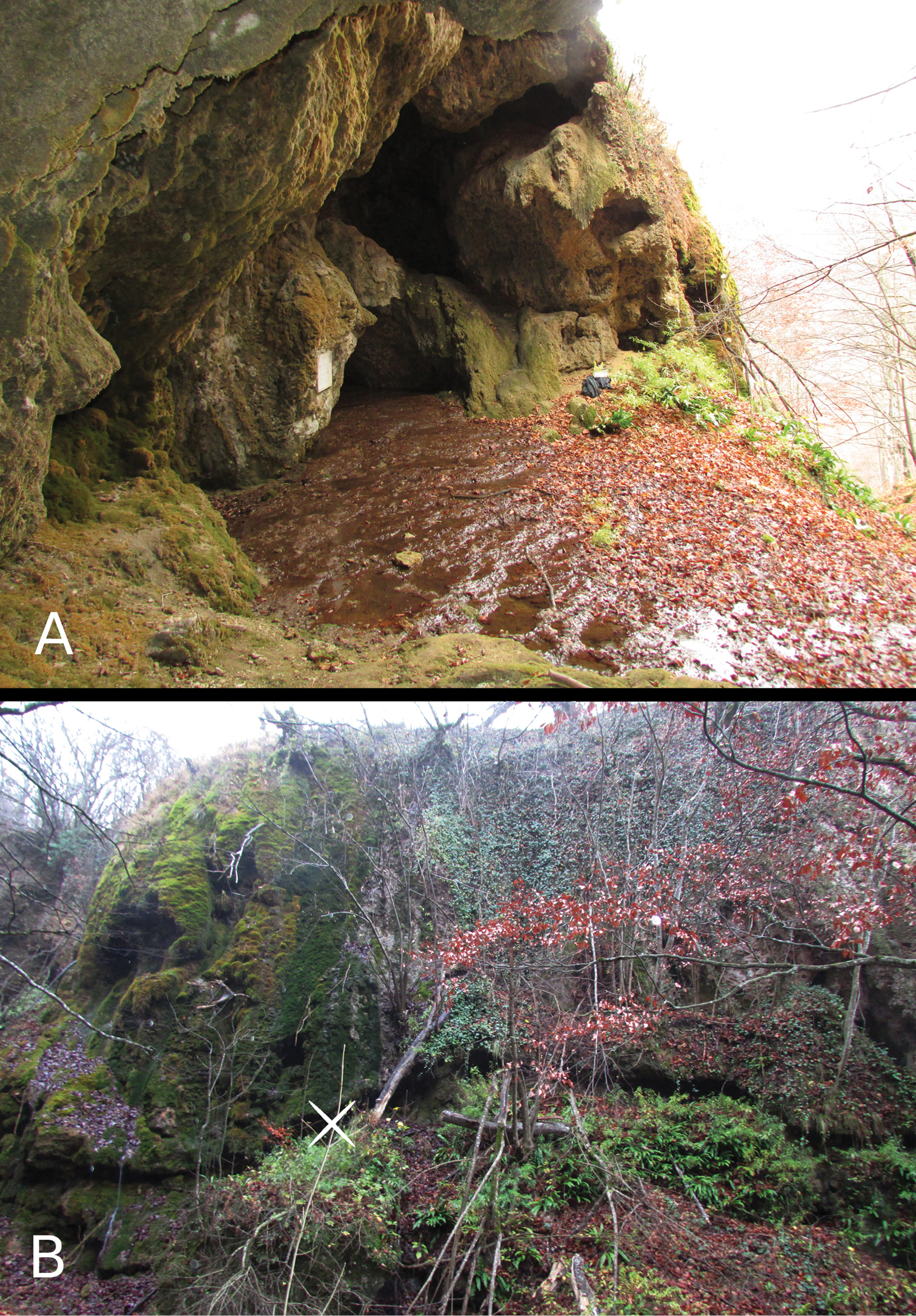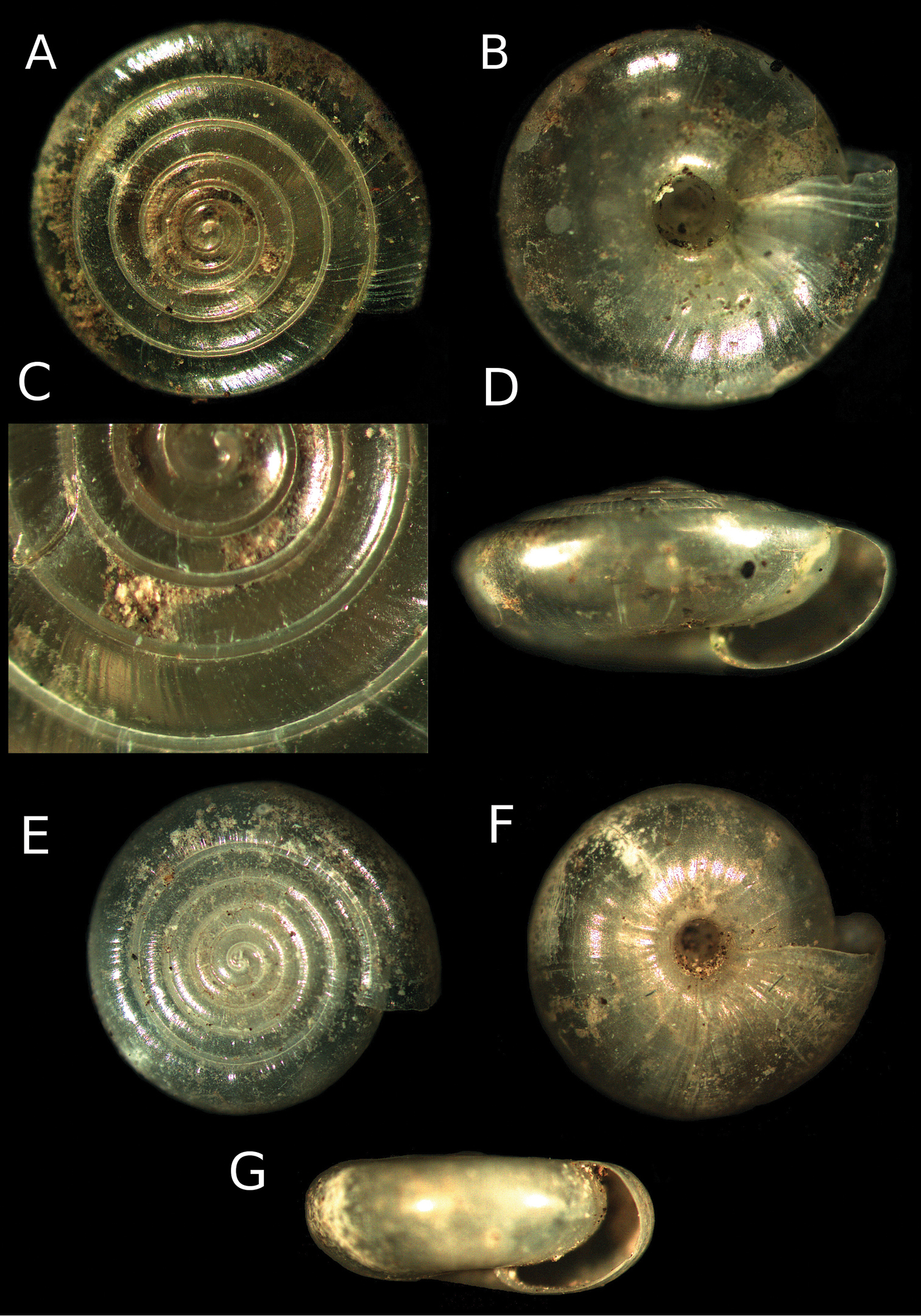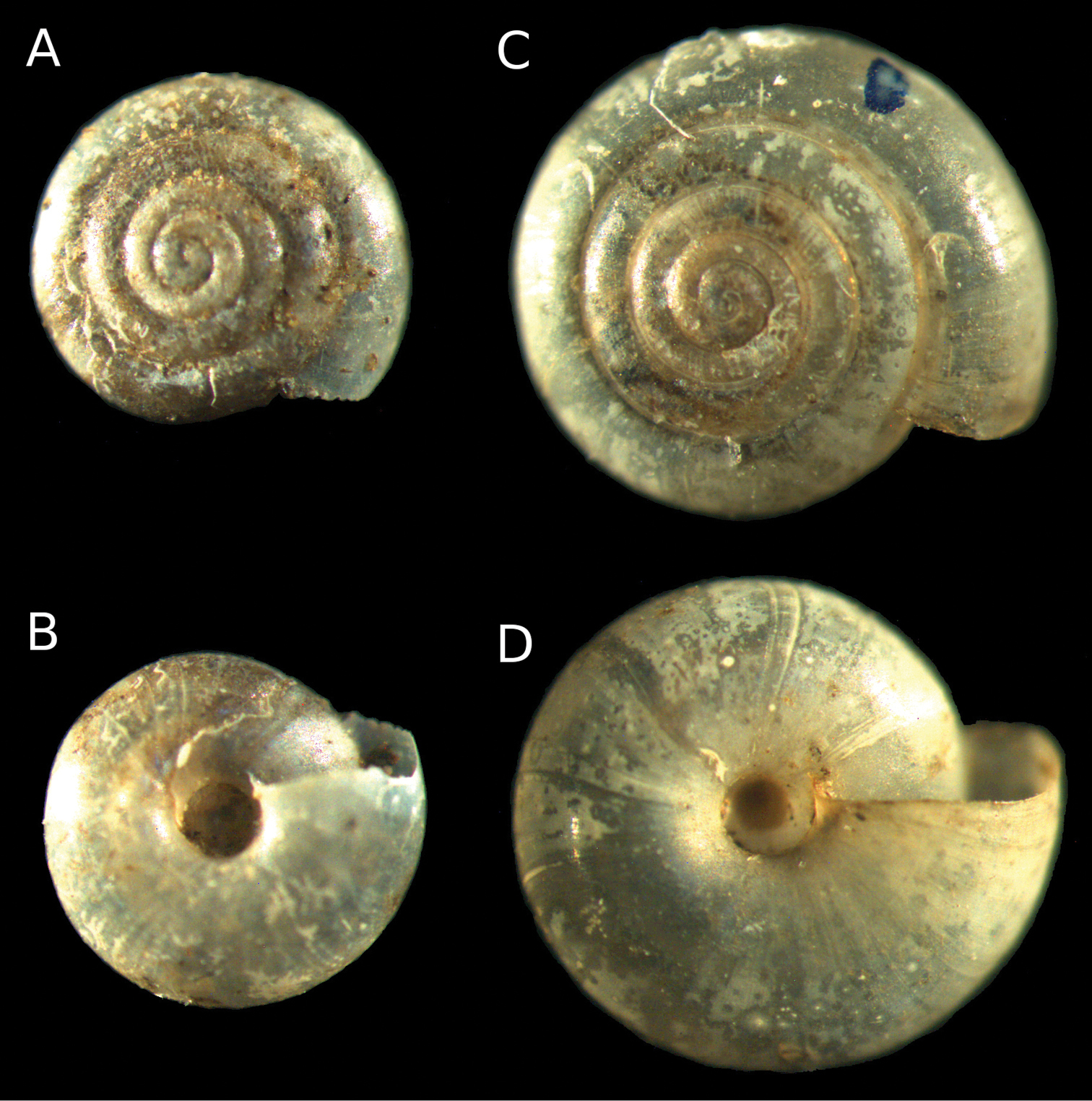






Citation: Georgiev D, Dedov I (2014) Contribution to the knowledge of the Bulgarian species of the genus Vitrea (Gastropoda, Pristilomatidae) with the description of a new species. ZooKeys 396: 1–11. doi: 10.3897/zookeys.396.6976
A new species of genus Vitrea is described: Vitrea ulrichi sp. n. is the eleventh species within the genus found in Bulgaria, and the largest representative of the Bulgarian Vitrea. Some critical notes on the taxonomy of the species V. bulgarica and V. sturanyi are presented. A key is provided for the determination of the species of Vitrea found in the country.
New species, Vitrea ulrichi sp. n., Bulgaria
The European species belonging to the genus Vitrea Fitzinger, 1833 (Gastropoda: Pristilomatidae) number 56 to date, many with local and scattered distribution patterns on the continent (
There are eleven species of Vitrea reported in the Bulgarian fauna till now (
All species of Vitrea living in Bulgaria can well be distinguished by their shell characters (
In this paper we describe a new species, Vitrea ulrichi sp. n. from the Stara Planina Mountain, Bulgaria, which can be distinguished from the most similar species Vitrea kutschigi (Walderdorff, 1864) and Vitrea sturanyi by its larger size, its angled shell, and very prominent shell sculpture.
The specimens of the new species (and other representatives of the local malacofauna) were collected by hand and with a double sieve system (1×1 and 2×2 mm).
Abbreviations used: Nw–number of whorls, H–height of shell, D–diameter of shell, Du–diameter of umbilicus, Dlw–diameter of last whorl, Dpw–diameter of penultimate whorl; SMF–“Senckenberg Forschungsinstitut und Naturmuseum”; NMNHS–“National Museum of Natural History, Sofia”.
Nw 6.25, H 2.1 mm, D 4.65 mm, Du 0.9 mm, Dlw 0.75 mm, Dpw 0.55 mm (SMF 341898).
2 specimens (SMF 341899/2).
The remaining paratypes are stored in the collections of the authors.
Surroundings of the Benkovskata Cave, near the village of Cherni Vit, Teteven town district, Stara Planina Mts, Bulgaria, 15–16.11.2013, leg. D. Georgiev, 10 adult, 5 juvenile specimens, 42°50'44.2"N, 24°10'29.8"E, 650 m (Fig. 1).
The type locality of Vitrea ulrichi sp. n.: the cave entrance (above) and the site of collection near the cave (below).
The species is named after our colleague and good friend Ulrich Schneppat (Natural History Museum, Chur, Switzerland) with gratitude for his great contribution to the knowledge of Bulgarian gastropods and for providing many literature sources, as well as for long and useful discussions with us on snails and slugs by email or around camp fires during our expeditions throughout Bulgaria.
Of all the Vitrea species reported for Bulgaria, the new species differs by its larger size, large number of whorls, and the intensely radially striated and angular shell. Considering the other European species and those distributed in the neighboring area of Asia Minor, the new species is most similar to Vitrea kutschigi known from Dalmatia, Serbia, Kosovo, and Macedonia, from which it differs by its coarsely striated and larger shell, higher spire, and position of the end of aperture edge on the last whorl, located at 1/3 of the last whorl in the Vitrea ulrichi sp. n. when compared to Vitrea kutschigi, where it is found on the upper side of the last whorl. The shape of the shell somewhat resembles that of Vitrea saboorii Neubert & Bössneck, 2013, but Vitrea ulrichi is bigger and has wider umbilicus.
The shell is translucent, yellowish-white, with 6.25–7 whorls which are densely and coarsely radially striated. The spire is low, broadly conical and elevated. The last whorl is angled at its periphery. The aperture is straight, moderately wide. In funnel perspective, the upper whorls are visible inside. The umbilicus is wide with a diameter of 0.75–1.05 mm, which represents approx. 1/5 of the shell’s diameter. The diameter of the last whorl width is less than 2 × the diameter of the penultimate whorl (Dlw 0.65–0.8 mm; Dpw 0.5–0.6 mm). The height of the shell is 2–2.35 mm. According to
A–D Vitrea ulrichi sp. n. Shell of the holotype with view of the embryonic protoconch E–G Vitrea kutschigi from Montenegro (Dedov coll. no. Mtn 366, ex. coll. P. Subai).
The type locality represents the surrounding area of a limestone water cave, with a small spring flowing below the cave near its entrance, providing constant air and soil moisture. The locality, where the new species was found, is a steep carbonate rock on the right side of the cave, densely covered with broad leaf detritus, mainly from Fagus sylvatica. The area is occupied by Fagus sylvatica and Carpinus betulus trees and bushes, as well as mosses and ferns (mostly Asplenium scolopendrium) covering the rocks (Fig. 1).
The terrestrial malacofauna diversity at the type locality was very rich. There were more than 20 species of land gastropods registered, within only on a few square meters of area: Carychium tridentatum (Risso, 1826), Agardhiella cf. pirotana Subai, 2011, Vallonia pulchella (O. F. Müller, 1774), Cochlicopa lubricella (Porro, 1838), Laciniaria cf. plicata (Draparnaud, 1801), Macedonica marginata (Rossmässler, 1835), Alinda wagneri (A. J.Wagner, 1911), Vestia ranojevici (Pavlovic, 1912), Euconulus fulvus (O. F. Müller, 1774), Vitrea diaphana (Studer, 1829), Vitrea transsylvanica (Clessin, 1877), Vitrea bulgarica Damjanov & L. Pintér, 1969, Vitrea contracta (Westerlund, 1871), Aegopinella pura (Alder, 1830), Oxychilus glaber (Rossmässler, 1838), Daudebardia brevipes (Draparnaud, 1805), Perforatella incarnata (O. F. Müller, 1774), Euomphalia strigella (Draparnaud, 1801), Cattania balcanica (Kobelt, 1876), and Cepaea vindobonensis (Férussac, 1821).
After the description of this new species, the genus Vitrea in Bulgaria encompasses eleven species. In this number, we also include some doubtful species such as Vitrea bulgarica and Vitrea sturanyi. Due to lack of anatomical data, we are not able to confine the new species to one of the existing subgenera.
The examination of material from genus Vitrea stored in the NMNHS revealed the existence of the holotype of Vitrea bulgarica (NMNHS 6627, information from the label: Asenovgrad, 24.07.1967, leg.L. Pintér) and a paratype of Vitrea neglecta (NMNHS 6704, information from the label: S. of Smolyan, 11.06.1967, leg. S. Damjanov, det. L. Pintér) (Fig. 3).
A, B Vitrea neglecta Damjanov & L. Pintér, 1969: paratype NMNHS 6704, C, D Vitrea bulgarica Damjanov & L. Pintér, 1969: holotype NMNHS 6627.
After studying these specimens, we found some differences existing between Vitrea bulgarica and Vitrea neglecta, which correspond to the original descriptions of both species (
Irikov’s opinion (2001) “between typical Vitrea neglecta and Vitrea bulgarica there are many intermediate forms, forming gradual series” could be interpreted as a confirmation of
The most important question for a correct determination of the species in genus Vitrea concerns the structures of the sexual system. According to
The occurrence of Vitrea sturanyi in Bulgaria, and even on the East Balkans, is disputable. Wagner (1907) described Vitrea sturanyi (as Crystallus sturanyi Wagner, 1907) from Bosnia, Krupa spring near Pazarich. Later,
Summarising the current knowledge on the genus Vitrea in Bulgaria, we propose the following key to identify the species within the country:
| 1 | umbilicus entirely closed | 2 |
| – | umbilicus more or less open | 4 |
| 2 | diameter of the last whorl only slightly wider than penultimate whorl | Vitrea diaphana diaphana |
| – | diameter of the last whorl almost 3 times wider than penultimate whorl | Vitrea transsylvanica |
| 4 | umbilicus with minute opening, through the umbilicus internal whorls cannot be seen, whorls is 4.5–5, diameter of the shell 3.0–4.3 mm | Vitrea subrimata |
| – | umbilicus much wider, the penultimate whorls through the umbilicus could be seen | 5 |
| 5 | diameter of the last whorl almost 2 times wider than penultimate whorl | 6 |
| – | diameter of the last whorl less wide (1.5 time than penultimate whorl or even less) | 7 |
| 6 | suture deep, mouth is wider, size smaller (in 3.5–4 whorls, diameter of shell 1.4–2.1 mm, the height of shell 0.7–0.8 mm) | Vitrea pygmaea |
| – | suture shallow, the mouth is narrowed, size bigger (in 4.5–5.5 whorls, diameter of shell 2.9–3.2 mm, the height of shell 1.3–1.5 mm) | Vitrea bulgarica |
| 7 | umbilicus perspective, very wide (about 1/3 from shell diameter), the whorls is 3–3.5 | V. verae |
| – | umbilicus perspective, moderately wide, 1/5 or even less from shell diameter, the whorls are 4.5 or more | 8 |
| 8 | umbilicus perspective, about 1/4–1/6 from shell diameter | 9 |
| – | umbilicus much narrow (about 1/12–1/14 of the shell diameter), the shell smooth, finely striated near the suture only, the bottom side of the shell rounded | Vitrea contracta |
| 9 | shell intensively radially striated, the number of whorls is 6.5–7, diameter of the shell big (4.65–5.3 mm), shell with angled periphery | Vitrea ulrichi sp. n. |
| – | shell smooth or finally striated, the number of whorls is smal 4.5–5.75, diameter of the less than 4.3 mm | 10 |
| 10 | shell smooth, the spire much conical, the umbilicus much wide (1/4–1/5 from shell diameter) | Vitrea riedeli |
| – | shell finally striated, the spire much depressed, the umbilicus much close (1/5–1/6 from shell diameter) | 11 |
| 11 | shell bigger (in 5 whorls diameter of the shell is 3.8–4.3 mm), umbilicus perspective-cylindrical | Vitrea cf. sturanyi |
| – | shell smaller (in 5 whorls diameter of the shell is 2.9–3 mm), umbilicus perspective-conical | Vitrea neglecta |
The authors are grateful to Barna Páll-Gergely (Shinshu University, Japan) and Francisco Welter-Schultes (University of Göttingen, Germany) for the very useful discussions considering the Vitrea species. We are also grateful to Peter Subai for his help with valuable samples of Vitrea kutschigi. Also we would like to thank to Dr. Nathalie Yonow (Swansea University, Wales) for linguistic corrections.


